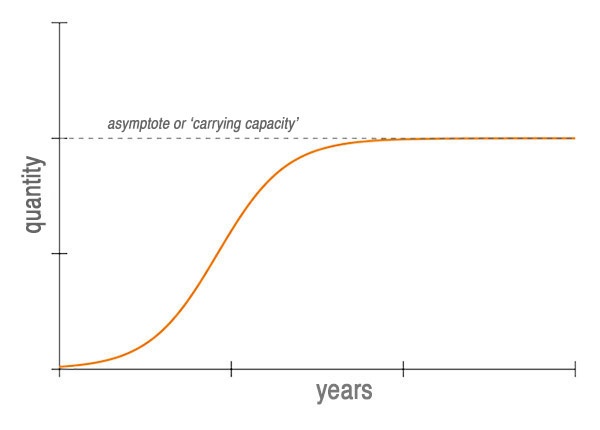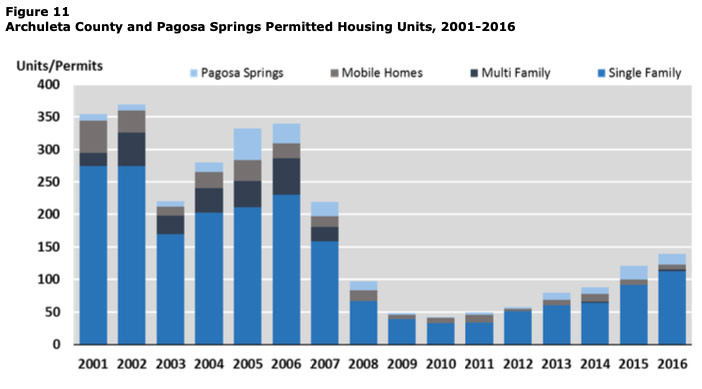Concern about ‘growth’ must be in the air. When I opened the weekly Pagosa Springs SUN newspaper yesterday, I saw that editor Terri House had written an op-ed titled:
“Growth or No Growth?”
She included, in her essay, a quote from Daily Post columnist Lee Riley… the very same comment I had also quoted at the beginning of this editorial series on Tuesday, when discussing the proposed ‘Pagosa Views’ subdivision:
“With this possible new development on the horizon, the debate continues: growth or no growth? The majority of the buyers I deal with want to be the last one in and shut the door behind them.”
Great minds think alike?
As Mr. Riley so accurately stated, many of the people who’ve settled in Pagosa over the past few decades — or who were born here, and stayed — have wished the growth of our community’s population could be graphed as an S-shaped ‘logistic growth’ curve…
… and that we were approaching the asymptote.
There’s little evidence, however, that this is the case. And considerable evidence to the contrary.
If we were to conclude that Pagosa Springs is close to its ‘carrying capacity’, then many of the discussions about our future might seem less fretful. We might not need to discuss, for example, the formation of a Vacation Rental Task Force, to work on the Short-Term Rental (STR) issues in Archuleta County.
Here’s some current information from the Archuleta County website:
Call for Volunteers for Vacation Rental Task Force
We are seeking one representative from each of these Stakeholder Groups:
- Realtor
- STR Owner*
- STR Neighbor*
- Hotel Representative
- Retail Representative
- STR Property Manager
- Restaurant Representative
- Housing Community Group Rep
- School District Representative
- PSMC Representative
- Tourism Board Representative
- PAWSD Representative
- LPEA Representative
- PLPOA Representative
- Condo Assoc. Representative
- Retired Resident Property Owner*
- Renting Resident
- At Large Member
*Must be unincorporated Archuleta County Resident
These volunteers will represent their community and work with an outside facilitator to develop language recommendations for the Archuleta County Land Use Regulations regarding Vacation Rentals in Unincorporated Archuleta County. We anticipate meeting twice a month for approximately 6 months starting in the later part of August, 2022.
If you fit into one of these groups, please submit a letter/email of interest to: Jamie Jones at jjones@archuletacounty.org, or call her at (970)264-8309 for assistance.

If we were looking for a case of ‘exponential growth’ in Archuleta County — as opposed to ‘logistic growth’ — we’d be hard-pressed to find a better example than the recent growth of the vacation rental industry here in Pagosa Springs, This industry was practically non-existent here, prior to the development of VRBO.com (in Breckenridge, 1995) and Airbnb.com (in San Francisco, 2008). Starting with few dozen vacation rentals, two decades ago, the industry has exploded in Archuleta County, thanks in part to a lack of regulations and enforcement. The tracking website AirDNA lists a total of 1,271 vacation rentals in the 81147 zip code (although some might be duplicate listings.)
The success of the STR industry has helped to drive up home prices and rental rates — a certain type of ‘economic growth’? — while diminishing the availability of affordable rentals and affordable homes and condos, and helping to create a shortage of available worker bees.
In other words, ‘economic growth’ in one industry has helped cause an overall ‘economic shortage’ in the community.
Yesterday in Part Three, I mentioned another instance of growth: government spending.
Some Daily Post readers may have already participated in the joint Town-County voter survey, now available at MyPagosa.org through August 16. Our two local governments want to know how we feel about raising the community’s total sales tax from 6.9% to 8.4%. You can take the survey here.
The survey does not reveal how our local governments would actually spend the money, but asks our opinion about that question. The survey results will be discussed at a joint Town-County work session on August 16 (the same day the survey closes.)
A word about the growth of government spending. In 2005, the population of Archuleta County was estimated at about 11,900 people (US Census). In 2021, the population was estimated at 13,790. According to my pocket calculator, that’s a population growth of about 15%.
In 2005, the Town of Pagosa Springs expended about $4.5 million fulfilling its municipal obligations. In 2021, the Town expenditures amounted to about $10.9 million.
According to my pocket calculator, that’s a spending growth of about 244%.
I lived here in 2005 when the Town’s budget was about $4.5 million, and I can’t recall people, then, complaining about the level of municipal services.
But growth happens… and it’s a funny thing about money. No matter how much money a government collects, it’s never enough.
Looking at the situation from a taxpayer’s point of view, we might wish that local government had already reached its ‘carrying capacity’. But apparently, that has not yet happened. The Town’s estimated budget for this year is $15.4 million… more than three times the 2005 budget.
One aspect of the community that appears poised for growth — as one result of increased municipal spending, and policy changes — is housing for working families and individuals.
Note the word, “poised”.
Data suggests that more than 1,000 residential homes in Archuleta County have been converted into commercial vacation rentals, and removed from the housing stock available to full-time residents. According to a recent housing study by Economic and Planning Systems, the community currently had about 10,200 housing units in 2016, suggesting that 10% of our housing is now dedicated to serving short-term visitors.
While this conversion of homes into commercial STRs was taking place, the Pagosa construction industry was suffering through a serious decline in new home construction, as indicated by this graph from the EPS report, below.
Prior to the Great Recession, Archuleta County and Pagosa Springs were seeing an average growth of around 300 new homes built each year. Then, things changed.
To make matters worse — as pointed out in a 2016 report from Region 9 Economic Development District — a majority of the (relatively few) homes built after 2007 were apparently ‘second homes’ that sit vacant for most of the year.
The Town of Pagosa Springs has invested more than $1 million, over the past year or so, to support workforce housing, with the purchase of three vacant residential parcels, and payment of development fees to Texas-based Servitas LLC. This ‘public-private partnership’ is projecting the construction of about 98 housing units — mostly rental apartments — aimed at addressing our shortage of housing for full-time residents.
Additionally, a group of investors from Arizona and New Mexico have proposed 675 housing units for a vacant 80-acre parcel immediately west of the Pagosa Springs Elementary School, with many of the planned units priced to serve working households. The development is calling itself ‘Pagosa Views’.
Between these two projects, the community could come close to addressing the current housing shortage — estimated at about 800 homes in a 2021 Root Policy housing needs study.
But all these new homes — if they get built — are still years off in the future, with the Pagosa Views subdivision assuming 8-10 years to full build-out.
Assuming it moves forward at all.
The growth we need might be coming, someday. The growth we don’t need seems to be here already.



